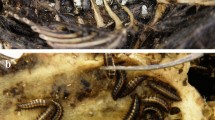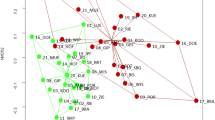Abstract
Many regions in Africa are currently being converted from subsistence to cash crop farming such as cotton. Agricultural intensification is usually accompanied by increased use of pesticides, which can have an impact on non-target organisms. Bats are particularly sensitive to insecticide loads while providing substantial ecosystem services as predators of herbivorous insects. In this study, pesticide residues in bats in a landscape in northern Benin were investigated, which spanned a land use gradient from an agricultural zone dominated by cotton farms, through a buffer zone, and into a national park. Insecticides used in cotton cultivation, such as endosulfan, chlorpyrifos, flubendiamide, and spirotetramat, as well as persistent insecticides such as bis(4-chlorophenyl)-1,1,1-trichloroethane (DDT), lindane, and aldrine, were analysed. Insecticide residues detected in bats comprised DDT, endosulfan, and their corresponding transformation products. Maximum concentrations in the sampled bats were 11.2 mg/kg lipid of p,p′-DDE (median: 0.0136 mg/kg lipid) and 0.797 mg/kg lipid of β-endosulfan (median: below detection limit [DL]). While insecticide concentrations were below lethal concentrations our data suggest that DDT had probably been recently used in the study region, and larger scale use would pose an increased risk for bat populations due to the high biomagnification of DDT.




Similar content being viewed by others
References
Allinson G, Mispagel C, Kajiwara N, Anan Y, Hashimoto J, Laurenson L, Allinson M, Tanabe S (2006) Organochlorine and trace metal residues in adult southern bent-wing bat (Miniopterus schreibersii bassanii) in southeastern Australia. Chemosphere 64:1464–1471
APVMA (2009a) Evaluation of the new active spirotetramat in the product Movento 240 SC insecticide, Australian Pesticides and Veterinary Medicines Authority, Canberra Australia. www.apvma.gov.au/registration/assessment/docs/prs_spirotetramat.pdf. Accessed 06 Nov 2013
APVMA (2009b) Evaluation of the new active flubendiamide in the product/s Belt 480 SC Insecticide & Belt 240 WG insecticide, Australian Pesticides and Veterinary Medicines Authority, Canberra Australia. www.apvma.gov.au/registration/assessment/docs/prs_flubendiamide.pdf. Accessed 06 Nov 2013
Armbrust K, Burns M, Crossan AN, Fischhoff AD, Hammond LE, Johnston JJ, Kennedy I, Rose MT, Seiber JN, Solomon K (2013) Perspectives on communicating risks of chemicals. J Agric Food Chem 61:4676–4691
Baecker G (2004) Relevance of risk management instruments for the cotton sector in West and Central Africa. GTZ Trade Programme, Eschborn. www2.gtz.de/dokumente/bib/04-0262.pdf. Accessed 06 Nov 2013
Bayat S, Geiser F, Kristiansen P, Wilson SC (2014) Organic contaminants in bats: trends and new issues. Environ Int 63:40–52
Bennett BS, Thies ML (2007) Organochlorine pesticide residues in guano of Brazilian free-tailed bats, Tadarida brasiliensis Saint-Hilaire, from east Texas. Bull Environ Contam Toxicol 78:191–194
Buttschardt TK, Zomahoun G-H (2005) Management von Großschutzgebieten: Das Beispiel des Réserve de la Biosphère da la Pendjari (Benin). In: Geoprojekte und deren Nutzung für die Bevölkerung Afrikas. Zbl Geo Pal Teil 1, Jg 2003: 379–387 (in German)
BVL L 00.00-34 (2010) Untersuchung von Lebensmitteln - Modulare Multimethode zur Bestimmung von Pflanzenschutzmittelrückständen in Lebensmitteln (Erweiterte Neufassung der DFG-Methode S 19). Beuth Verlag, Berlin (in German)
Chan MPL, Morisawa S, Nakayama A, Kawamoto Y, Sugimoto M, Yoneda M (2005) Toxicokinetics of 14C-endosulfan in male Sprague–Dawley rats following oral administration of single or repeated doses. Environ Toxicol 20:533–541
Clark DR Jr (1981) Death in bats from DDE, DDT or dieldrin: diagnosis via residues in carcass fat. Bull Environ Contam Toxicol 26:367–374
Clark DR Jr, Stafford CJ (1981) Effects of DDE and PCB (Aroclor 1260) on experimentally poisoned female little brown bats Myotis lucifugus: lethal brain concentrations. J Toxicol Environ Health 7:925–934
Clark DR Jr, Moreno-Valdez A, Mora MA (1995) Organochlorine residues in bat guano from nine Mexican caves, 1991. Ecotoxicology 4:258–265
Clark DR Jr (2001) DDT and the decline of free-tailed bats (Tadarida brasiliensis) at Carlsbad Cavern, New Mexico. Arch Environ Contam Toxicol 40:537–543
Clark DR Jr, Shore RF (2001) Chiroptera. In: Shore RF, Rattner BA (eds) Ecotoxicology of wild mammals. Wiley, New York, pp 159–214
Cleveland CJ, Betke M, Federico P, Frank JD, Hallam TG, Horn J, López JD Jr, McCracken GF, Medellín RA, Moreno-Valdez A, Sansone CG, Westbrook JK, Kunz TH (2006) Economic value of the pest control service provided by Brazilian free-tailed bats in south-central Texas. Front Ecol Environ 4:238–243
DG Sanco (2011) Method validation and quality control procedures for pesticide residues analysis in food and feed. Document No. SANCO/12495/2011, European Commission. www.crl-pesticides.eu/library/docs/fv/SANCO12495-2011.pdf. Accessed 06 Nov 2013
DIN 32645 (2008) Chemical analysis — decision limit, detection limit and determination limit under repeatability conditions — terms, methods, evaluation. Beuth Verlag, Berlin (in German)
Dorough HW, Huhtanen K, Marshall TC, Bryant HE (1978) Fate of endosulfan in rats and toxicological considerations of apolar metabolites. Pest Biochem Physiol 8:241–252
Fahr J, Kalko EKV (2011) Biome transitions as centres of diversity: habitat heterogeneity and diversity patterns of West African bat assemblages across spatial scales. Ecography 34:177–195
Falk U, Szarzynski J (2010) Sub-Saharan West Africa climate and precipitation regime. In: Sinsin B, Kampmann D (eds) Biodiversity atlas of West Africa, vol 1. Bénin, Cotonou & Frankfurt/Main, pp 44–51
Federico P, Hallam TG, McCracken GF, Purucker ST, Grant WE, Correa-Sandoval AN, Westbrook JK, Medellín RA, Cleveland CJ, Sansone CG, López JD Jr, Betke M, Moreno-Valdez A, Kunz TH (2008) Brazilian free-tailed bats as insect pest regulators in transgenic and conventional cotton crops. Ecol Appl 18:826–837
Geluso KN, Altenbach JS, Wilson DE (1976) Bat mortality: pesticide poisoning and migratory stress. Science 194:184–186
Hernández LM, Ibánez C, Fernández MA, Al G, González MJ, Pérez JL (1993) Organochlorine insecticides and PCB residues in two bat species from four localities in Spain. Bull Environ Contam Toxicol 50:871–877
IPCS INCHEM-database (2012) Environmental Health Criteria Monographs (EHCs), International Programme on Chemical Safety (IPCS). www.inchem.org/pages/ehc.html. Accessed 06 Nov 2013
Jefferies DJ (1972) Organochlorine insecticide residues in British bats and their significance. J Zool 166:245–263
Jones G, Jacobs DS, Kunz TH, Willig MR, Racey PA (2009) Carpe noctem: the importance of bats as bioindicators. Endang Species Res 8:93–115
Kannan K, Yun SH, Rudd RJ, Behr MJ (2010) High concentrations of persistent organic pollutants including PCBs, DDT, PBDEs and PFOS in little brown bats with white-nose syndrome in New York, USA. Chemosphere 80:613–618
Kunz TH, Braun de Torrez E, Bauer D, Lobova TA, Fleming TH (2011) Ecosystem services provided by bats. Ann NY Acad Sci 1223:1–38
Kuvarega AT, Taru P (2007) Accumulation of endosulfan in wild rat, Rattus norvegious as a result of application to soya bean in Mazoe (Zimbabwe). Environ Monit Assess 125:333–345
Lehmkuhl Noer C, Dabelsteen T, Bohmann K, Monadjem A (2012) Molossid bats in an African agro-ecosystem select sugarcane fields as foraging habitat. Afr Zool 47:1–11
Luckens MM, Davis WH (1964) Bats: sensitivity to DDT. Science 146:948
Luckens MM (1967) Seasonal changes in the sensitivity of bats to DDT. In: Deichmann WB (ed) Pesticides and the environment: a continuing controversy. Intercontinental Medical Book, New York, 1973, pp. 63–75
Marais WC (2009) The potential of using insectivorous bats (Microchiroptera) as a means of insect pest control in agricultural areas. MSc Thesis, University of Johannesburg, p 120
Matthiessen P (1985) Contamination of wildlife with DDT insecticide residues in relation to tsetse fly control operations in Zimbabwe. Environ Pollut Ser B 10:189–211
McWilliam AN (1994) Nocturnal animals. In: Douthwaite RJ, Tingle CCD (eds) DDT in the Tropics: the impact on wildlife in Zimbabwe of ground-spraying for tsetse fly control. Natural Resources Institute (NRI), Chatham, pp 103–133
Monadjem A, Reside A, Cornut J, Perrin MR (2009) Roost selection and home range of an African insectivorous bat Nycteris thebaica (Chiroptera, Nycteridae). Mammalia 73:353–359
Nagel A, Disser J (1990) Rückstände von Chlorkohlenwasserstoff-Pestiziden in einer Wochenstube der Zwergfledermaus (Pipistrellus pipistrellus). Mamm biol 55:217–225 (in German)
OECD/African Development Bank/United Nations Economic Commission for Africa (2009), African Economic Outlook 2009, OECD Publishing. doi:10.1787/aeo-2009-en
Oerke EC (2006) Centenary review – crop losses to pests. J Agricult Sci 144:31–43
O'Shea TJ, Everette AL, Ellison LE (2001) Cyclodiene insecticide, DDE, DDT, arsenic, and mercury contamination of big brown bats (Eptesicus fuscus) foraging at a Colorado Superfund Site. Arch Environ Contam Toxicol 40:112–120
O'Shea TJ, Johnston JJ (2009) Environmental contaminants and bats: Investigating exposure and effects. In: Parsons S (ed) Kunz TH. Ecological and behavioral methods for the study of bats. John Hopkins University Press, Baltimore, pp 500–528
PAN/IPEN (2009) Endosulfan in West Africa: adverse effects, its banning, and alternatives. Pesticide Action Network Africa. Dakar, Senegal. www.ipen.org/ipenweb/documents/ipen%20documents/endosulfan_wa_cop4.pdf. Accessed 06 Nov 2013)
Paré S, Kaboré B, Stechert C, Kolb M, Bahadir M, Bonzi-Coulibaly LY (2014) Agricultural practice and pesticides residues in soils and pool sediments from the Pendjari Biosphere Reserve area in Benin, West Africa. Clean, accepted
Peveling R, McWilliam AN, Nagel P, Rasolomanana H, Raholijaona L, Rakotomianina L, Ravoninjatova A, Dewhurst CF, Gibson G, Rafanomezan S, Tingle CCD (2003) Impact of locust control on harvester termites and endemic vertebrate predators in Madagascar. J Appl Ecol 40:729–741
Rogan WJ, Chen A (2005) Health risks and benefits of bis(4-chlorophenyl)-1,1,1-trichloroethane (DDT). Lancet 366:763–773
Senthilkumar K, Kannan K, Subramanian A, Tanabe S (2001) Accumulation of organochlorine pesticides and polychlorinated biphenyls in sediments, aquatic organisms, birds, bird eggs and bat collected from South India. Environ Sci Pollut R 8:35–47
Sikes RS, Gannon WL, Animal Care and Use Committee of the ASM (2011) Guidelines of the American Society of Mammalogists for the use of wild mammals in research. J Mammal 92:235–253
Sinsin B, Tehou AC, Daouda I, Saidou A (2002) Abundance and species richness of larger mammals in Pendjari National Park in Benin. Mammalia 66:369–380
Stahlschmidt P, Brühl CA (2012) Bats at risk? Bat activity and insecticide residue analysis of food items in an apple orchard. Environ Toxicol Chem 31:1556–1563
Stockholm Convention on Persistent Organic Pollutants (POPs) as amended in 2011. http://chm.pops.int/. Accessed 06 Nov 2013
Tavares TM, Beretta M, Costa MC (1999) Ratio of DDT/DDE in the All Saints Bay, Brazil and its use in environmental management. Chemosphere 38:1445–1452
Tomlin CDS (ed) (2006) A world compendium — the pesticide manual, 14th edn. Hampshire, BCPC
Vodouhe DS, Watts M, Sanfilippo D (2008) Endosulfan banned in Benin. Pesticides News 79:1–3, www.pan-uk.org/pn/pesticide-news. Accessed 06 Nov 2013
WHO (2008) World Malaria Report 2008. Geneva. www.who.int/malaria/publications/atoz/9789241563697/en/index.html. Accessed 06 Nov 2013
Acknowledgments
This work is a contribution of the BIOTA Africa program, funded by the German Federal Ministry of Education and Research (BMBF, projects 01LC0617F and 01LC0617E1). We gratefully acknowledge both local and national authorities granting the necessary permits to carry out field work and to collect bat specimens in the Pendjari region, in particular the Centre National de Gestion des Réserves de Faune (CENAGREF), and the director of the Pendjari NP, Djafarou A. Tiomoko, as well as Udo Lange and Aristide Tehou. Furthermore, we thank Konstantin König and Karen Hahn, Goethe University Frankfurt, for providing us with their vegetation map of the Pendjari National Park. Two anonymous reviewers helped to improve a previous version of this manuscript.
Author information
Authors and Affiliations
Corresponding author
Additional information
Responsible editor: Laura McConnell
Electronic supplementary material
Below is the link to the electronic supplementary material.
Online Resource 1
(DOC 47 kb)
Online Resource 2
(DOC 70 kb)
Rights and permissions
About this article
Cite this article
Stechert, C., Kolb, M., Bahadir, M. et al. Insecticide residues in bats along a land use-gradient dominated by cotton cultivation in northern Benin, West Africa. Environ Sci Pollut Res 21, 8812–8821 (2014). https://doi.org/10.1007/s11356-014-2817-8
Received:
Accepted:
Published:
Issue Date:
DOI: https://doi.org/10.1007/s11356-014-2817-8




